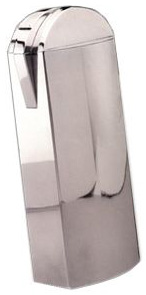Back to Brochures
|
An appreciation for the highly-motivated march to Modernism in the visual arts may be found in its rhythmic flow, its syncopation. First, a breakthrough statement is initiated followed by variations which extend, reshape and eventually transform the original idea into its opposite extreme – visions and revisions. In design this "progression" may be documented from many vantage points: chronologically, by object type, by artist/designer, by nation, by styles and movements, and by media such as ceramics, glassware and metalwork. Each offers a unique and informative perspective on what is now widely regarded as the most creative period in design history. Metal is the unifying theme in Norwest's ninth exhibition, Modernist Metalwork: 1900-1940. From a collection of 400 pieces, nearly one fourth are metalare. The exhibition provides a microcosm of Modernism characterized by a continuous path of reductivism, the elimination of surface decoration and the refinement of form. As in other media, the course is anything but constant; in fact, far slower than in painting and sculpture due largely to an extremely conservative clientele. Still, orthodoxy, historicism and tradition were systematically abandoned by those forward-looking designers favoring idioms that conveyed the present tense. Near the turn of the century quality design and workmanship in silver, pewter, brass and copper was revived by the British Arts and Crafts movement where the virtue of handmade objects was stressed. Art Nouveau designers worked across the complete range of metals, from cast-iron and bronze to silver, mixing them with enamels, ivory and exotic woods, shaping metal into extravagant organic forms, the sumptuous and the sinuous, while simultaneously addressing a duality of purpose. Many designers produced handmade, exclusive objects of extraordinary artistry while others tailored their designs to large-scale production utilizing new machine technology. The Wiener Werkstätte, founded in Vienna in 1903, and The Deutsche Werkbund, founded in Munich in 1907, aimed at "enhancing the position of craftsmanship through cooperation between art, industry and handicraft." In 1923, the celebrated German Bauhaus school of art, craft and design, took a dramatic turn from the hand-crafted towards industrial design advocating new unadorned forms, clean lines and a form follows function manifesto. Steel sheeting became a preferred medium over silver. Emphasis irrevocably shifted towards the education of a new breed of designer capable of conceiving machine-made artifacts. Adaptability and inventiveness flourished in Art Deco metalwork often imaginatively employed with other exotic materials. In the '20s wrought iron, bronze, copper and silver were commonplace. By the early '30s the more favored moderne metals became silverplate, aluminum, steel and chrome, all remarkable for their industrial finish and gleaming surface. Rational engineering and mass production had become finely tempered by the artist's quest for perfected form.
David Ryan |
 MODERNIST
MODERNIST